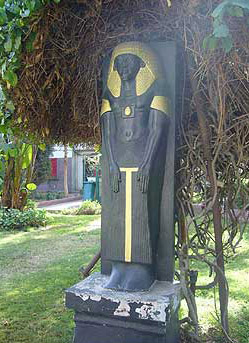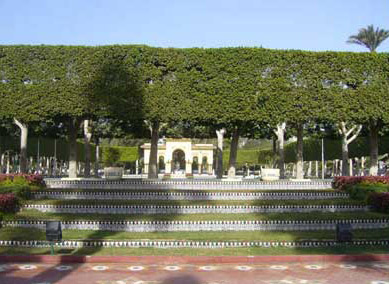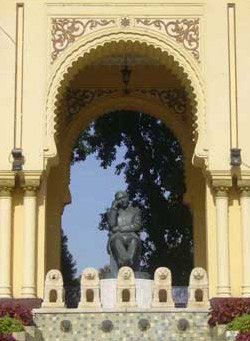The Andalusian Garden In Cairoby Lara Iskander
View of Saad Zaghloul Statue with the Opera House in the Background
A view of Qasr Al-Nil Bridge Cairo is a densely populated city, with green spaces few and far between. However, many parks have survived the urban sprawl and bigger attention is constantly given to preserving Cairo's green spaces and increasing them.
A view of the Cairo Tower
The Nile from Andalus Park One of the districts known for its vast green spaces is the island of Zamalek. The southern part of Zamalek is where the greenery is most preserved; this is partially due to the fact that there are three sporting clubs located there.
The Pedestrian Walkway along the Nile
The Andalusian Garden
The Andalusian Garden, or 'Hadikat Al-Andalus', is located in Gezira between Qasr al-Nil Bridge and Sixth October Bridge. This is a wonderful little park located in the southern part of Zamalek Island, just minutes away from the downtown area.
View of the Garden Terraces
One of the many pharaonic replicas in the Gardens
Directly behind the Statue and facing the square is the entrance to the Cultural Centre building, located within the Cairo Opera House grounds which was inaugurated in 1988. However the Cultural Centre is a late addition to the complex where many art exhibitions take place. Nearby, the 187 meter Cairo Tower is easily spotted; the landmark of the island was built between 1956 till 1961 and is 43 meters higher than the Pyramid of Giza. On a clear day, one can enjoy an amazing panoramic view of the city from the top of the concrete lotus blossom of the Cairo Tower.
The park itself is very pleasant with well kept greenery, walkways, benches from where one can quietly observe the Nile and crossing-by feluccas. A quite walk along the Nile banks while admiring the scenery of lush gardens and beautiful landscapes certainly separates one from the noise and hassle of the city traffic.
Walkway though a Pavilion with a Statue of Ahmed Shawky
The Ahmed Shawky Statue Overlooks the Gardens
The park is laid out in a Moorish and Arabic style and is considered a favorite destination for the inhabitants of Cairo. The park is divided in three sections. The first section is mainly composed of narrow passages with different trees and plantation surrounding them and several replicas of ancient Egyptian statues. There are two round terraces at the edge of the park where you can enjoy refreshments apart from several well hidden sitting areas in covered green sheds. Palm trees tower the garden giving an admirable feeling of seclusion from the surrounding streets while at the same time, well defining the paved passageways.
Shawky pioneered the modern Arabic Literary movement and he is also known to have produced distinctive poetry widely considered to be the most prominent of the 20th century Arabic literary movement.His home in Giza, which he bought in 1914, provided a meeting space for musicians, singers, statesmen, and literary writers. The site became the Ahmed Shawky Museum in 1977.
All steps and benches are decorated with fine and colorful mosaic. At the far end of the park and opposite the statue is the main entrance which looks on to the Gezira Square. The third part is named 'Al-Fardus' and it has an arabesque design and architecture. From this section one can get the best views of the Nile and the skyline of downtown area. This is a favorite hide-away place for young Cairenes. On the right of the park is a pedestrian promenade along the banks of the Nile which gives it a nice continuity. The garden is currently administrated by the Department of Special Gardens, Cairo Governorate. Entrance fee is two pounds. Opening hours in summer are from 9am to 2am and in winter, from 9am till 10pm. |

















